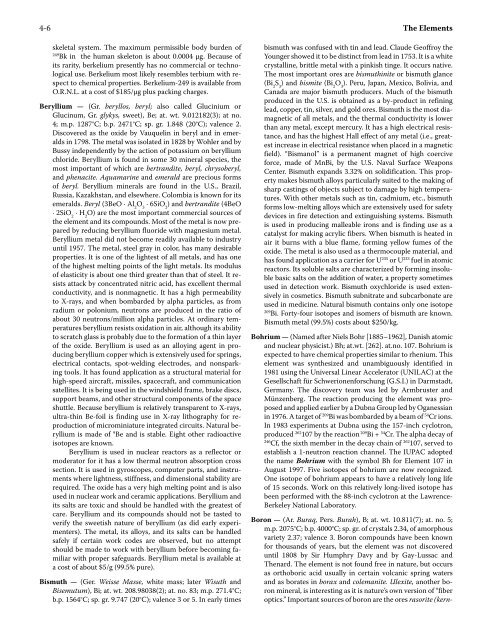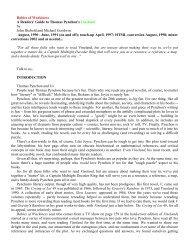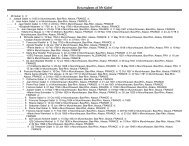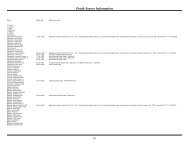CRC Handbook of Chemistry and Physics, 86th Edition
CRC Handbook of Chemistry and Physics, 86th Edition
CRC Handbook of Chemistry and Physics, 86th Edition
You also want an ePaper? Increase the reach of your titles
YUMPU automatically turns print PDFs into web optimized ePapers that Google loves.
4-6 The Elements<br />
skeletal system. The maximum permissible body burden <strong>of</strong><br />
249 Bk in the human skeleton is about 0.0004 µg. Because <strong>of</strong><br />
its rarity, berkelium presently has no commercial or technological<br />
use. Berkelium most likely resembles terbium with respect<br />
to chemical properties. Berkelium-249 is available from<br />
O.R.N.L. at a cost <strong>of</strong> $185/µg plus packing charges.<br />
Beryllium — (Gr. beryllos, beryl; also called Glucinium or<br />
Glucinum, Gr. glykys, sweet), Be; at. wt. 9.012182(3); at no.<br />
4; m.p. 1287°C; b.p. 2471°C; sp. gr. 1.848 (20°C); valence 2.<br />
Discovered as the oxide by Vauquelin in beryl <strong>and</strong> in emeralds<br />
in 1798. The metal was isolated in 1828 by Wohler <strong>and</strong> by<br />
Bussy independently by the action <strong>of</strong> potassium on beryllium<br />
chloride. Beryllium is found in some 30 mineral species, the<br />
most important <strong>of</strong> which are bertr<strong>and</strong>ite, beryl, chrysoberyl,<br />
<strong>and</strong> phenacite. Aquamarine <strong>and</strong> emerald are precious forms<br />
<strong>of</strong> beryl. Beryllium minerals are found in the U.S., Brazil,<br />
Russia, Kazakhstan, <strong>and</strong> elsewhere. Colombia is known for its<br />
emeralds. Beryl (3BeO · Al 2 O 3 · 6SiO 2 ) <strong>and</strong> bertr<strong>and</strong>ite (4BeO<br />
· 2SiO 2 · H 2 O) are the most important commercial sources <strong>of</strong><br />
the element <strong>and</strong> its compounds. Most <strong>of</strong> the metal is now prepared<br />
by reducing beryllium fluoride with magnesium metal.<br />
Beryllium metal did not become readily available to industry<br />
until 1957. The metal, steel gray in color, has many desirable<br />
properties. It is one <strong>of</strong> the lightest <strong>of</strong> all metals, <strong>and</strong> has one<br />
<strong>of</strong> the highest melting points <strong>of</strong> the light metals. Its modulus<br />
<strong>of</strong> elasticity is about one third greater than that <strong>of</strong> steel. It resists<br />
attack by concentrated nitric acid, has excellent thermal<br />
conductivity, <strong>and</strong> is nonmagnetic. It has a high permeability<br />
to X-rays, <strong>and</strong> when bombarded by alpha particles, as from<br />
radium or polonium, neutrons are produced in the ratio <strong>of</strong><br />
about 30 neutrons/million alpha particles. At ordinary temperatures<br />
beryllium resists oxidation in air, although its ability<br />
to scratch glass is probably due to the formation <strong>of</strong> a thin layer<br />
<strong>of</strong> the oxide. Beryllium is used as an alloying agent in producing<br />
beryllium copper which is extensively used for springs,<br />
electrical contacts, spot-welding electrodes, <strong>and</strong> nonsparking<br />
tools. It has found application as a structural material for<br />
high-speed aircraft, missiles, spacecraft, <strong>and</strong> communication<br />
satellites. It is being used in the windshield frame, brake discs,<br />
support beams, <strong>and</strong> other structural components <strong>of</strong> the space<br />
shuttle. Because beryllium is relatively transparent to X-rays,<br />
ultra-thin Be-foil is finding use in X-ray lithography for reproduction<br />
<strong>of</strong> microminiature integrated circuits. Natural beryllium<br />
is made <strong>of</strong> 9 Be <strong>and</strong> is stable. Eight other radioactive<br />
isotopes are known.<br />
Beryllium is used in nuclear reactors as a reflector or<br />
moderator for it has a low thermal neutron absorption cross<br />
section. It is used in gyroscopes, computer parts, <strong>and</strong> instruments<br />
where lightness, stiffness, <strong>and</strong> dimensional stability are<br />
required. The oxide has a very high melting point <strong>and</strong> is also<br />
used in nuclear work <strong>and</strong> ceramic applications. Beryllium <strong>and</strong><br />
its salts are toxic <strong>and</strong> should be h<strong>and</strong>led with the greatest <strong>of</strong><br />
care. Beryllium <strong>and</strong> its compounds should not be tasted to<br />
verify the sweetish nature <strong>of</strong> beryllium (as did early experimenters).<br />
The metal, its alloys, <strong>and</strong> its salts can be h<strong>and</strong>led<br />
safely if certain work codes are observed, but no attempt<br />
should be made to work with beryllium before becoming familiar<br />
with proper safeguards. Beryllium metal is available at<br />
a cost <strong>of</strong> about $5/g (99.5% pure).<br />
Bismuth — (Ger. Weisse Masse, white mass; later Wisuth <strong>and</strong><br />
Bisemutum), Bi; at. wt. 208.98038(2); at. no. 83; m.p. 271.4°C;<br />
b.p. 1564°C; sp. gr. 9.747 (20°C); valence 3 or 5. In early times<br />
bismuth was confused with tin <strong>and</strong> lead. Claude Ge<strong>of</strong>froy the<br />
Younger showed it to be distinct from lead in 1753. It is a white<br />
crystalline, brittle metal with a pinkish tinge. It occurs native.<br />
The most important ores are bismuthinite or bismuth glance<br />
(Bi 2 S 3 ) <strong>and</strong> bismite (Bi 2 O 3 ). Peru, Japan, Mexico, Bolivia, <strong>and</strong><br />
Canada are major bismuth producers. Much <strong>of</strong> the bismuth<br />
produced in the U.S. is obtained as a by-product in refining<br />
lead, copper, tin, silver, <strong>and</strong> gold ores. Bismuth is the most diamagnetic<br />
<strong>of</strong> all metals, <strong>and</strong> the thermal conductivity is lower<br />
than any metal, except mercury. It has a high electrical resistance,<br />
<strong>and</strong> has the highest Hall effect <strong>of</strong> any metal (i.e., greatest<br />
increase in electrical resistance when placed in a magnetic<br />
field). “Bismanol” is a permanent magnet <strong>of</strong> high coercive<br />
force, made <strong>of</strong> MnBi, by the U.S. Naval Surface Weapons<br />
Center. Bismuth exp<strong>and</strong>s 3.32% on solidification. This property<br />
makes bismuth alloys particularly suited to the making <strong>of</strong><br />
sharp castings <strong>of</strong> objects subject to damage by high temperatures.<br />
With other metals such as tin, cadmium, etc., bismuth<br />
forms low-melting alloys which are extensively used for safety<br />
devices in fire detection <strong>and</strong> extinguishing systems. Bismuth<br />
is used in producing malleable irons <strong>and</strong> is finding use as a<br />
catalyst for making acrylic fibers. When bismuth is heated in<br />
air it burns with a blue flame, forming yellow fumes <strong>of</strong> the<br />
oxide. The metal is also used as a thermocouple material, <strong>and</strong><br />
has found application as a carrier for U 235 or U 233 fuel in atomic<br />
reactors. Its soluble salts are characterized by forming insoluble<br />
basic salts on the addition <strong>of</strong> water, a property sometimes<br />
used in detection work. Bismuth oxychloride is used extensively<br />
in cosmetics. Bismuth subnitrate <strong>and</strong> subcarbonate are<br />
used in medicine. Natural bismuth contains only one isotope<br />
209 Bi. Forty-four isotopes <strong>and</strong> isomers <strong>of</strong> bismuth are known.<br />
Bismuth metal (99.5%) costs about $250/kg.<br />
Bohrium — (Named after Niels Bohr [1885–1962], Danish atomic<br />
<strong>and</strong> nuclear physicist.) Bh; at.wt. [262]. at.no. 107. Bohrium is<br />
expected to have chemical properties similar to rhenium. This<br />
element was synthesized <strong>and</strong> unambiguously identified in<br />
1981 using the Universal Linear Accelerator (UNILAC) at the<br />
Gesellschaft für Schwerionenforschung (G.S.I.) in Darmstadt,<br />
Germany. The discovery team was led by Armbruster <strong>and</strong><br />
Münzenberg. The reaction producing the element was proposed<br />
<strong>and</strong> applied earlier by a Dubna Group led by Oganessian<br />
in 1976. A target <strong>of</strong> 209 Bi was bombarded by a beam <strong>of</strong> 54 Cr ions.<br />
In 1983 experiments at Dubna using the 157-inch cyclotron,<br />
produced 262 107 by the reaction 209 Bi + 54 Cr. The alpha decay <strong>of</strong><br />
246 Cf, the sixth member in the decay chain <strong>of</strong> 262 107, served to<br />
establish a 1-neutron reaction channel. The IUPAC adopted<br />
the name Bohrium with the symbol Bh for Element 107 in<br />
August 1997. Five isotopes <strong>of</strong> bohrium are now recognized.<br />
One isotope <strong>of</strong> bohrium appears to have a relatively long life<br />
<strong>of</strong> 15 seconds. Work on this relatively long-lived isotope has<br />
been performed with the 88-inch cyclotron at the Lawrence-<br />
Berkeley National Laboratory.<br />
Boron — (Ar. Buraq, Pers. Burah), B; at. wt. 10.811(7); at. no. 5;<br />
m.p. 2075°C; b.p. 4000°C; sp. gr. <strong>of</strong> crystals 2.34, <strong>of</strong> amorphous<br />
variety 2.37; valence 3. Boron compounds have been known<br />
for thous<strong>and</strong>s <strong>of</strong> years, but the element was not discovered<br />
until 1808 by Sir Humphry Davy <strong>and</strong> by Gay-Lussac <strong>and</strong><br />
Thenard. The element is not found free in nature, but occurs<br />
as orthoboric acid usually in certain volcanic spring waters<br />
<strong>and</strong> as borates in borax <strong>and</strong> colemanite. Ulexite, another boron<br />
mineral, is interesting as it is nature’s own version <strong>of</strong> “fiber<br />
optics.” Important sources <strong>of</strong> boron are the ores rasorite (kern-







